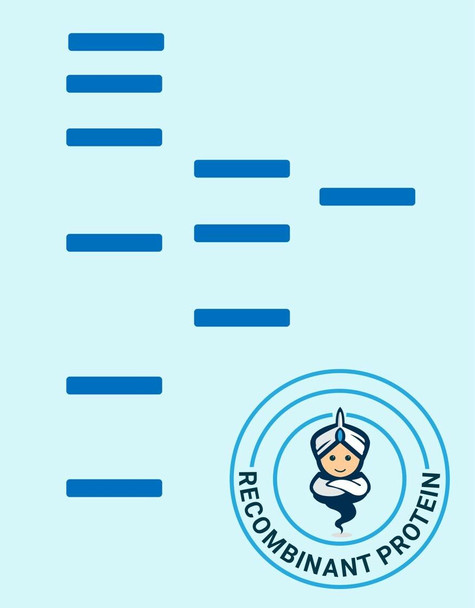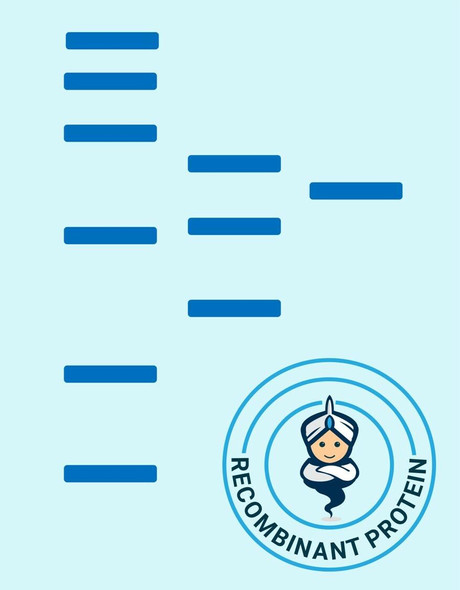Human IL23R Recombinant Protein (RPPB0645)
- SKU:
- RPPB0645
- Product type:
- Recombinant Protein
- Size:
- 10ug
- Species:
- Human
- Target:
- IL23R
- Synonyms:
- Interleukin 23 Receptor
- IL-23 Receptor
- IL-23R
- IL23R
- Source:
- Sf9 Insect cells
- Uniprot:
- Q5VWK5
Description
| Product Name: | Human IL23R Recombinant Protein |
| Product Code: | RPPB0645 |
| Size: | 10µg |
| Species: | Human |
| Target: | IL23R |
| Synonyms: | Interleukin 23 Receptor, IL-23 Receptor, IL-23R, IL23R. |
| Source: | Sf9 Insect cells |
| Physical Appearance: | Sterile filtered colorless solution. |
| Formulation: | IL23R protein solution (0.25mg/ml) contains Phosphate Buffered Saline (pH7.4) and 10% glycerol. |
| Stability: | Store at 4°C if entire vial will be used within 2-4 weeks. Store, frozen at -20°C for longer periods of time. For long term storage it is recommended to add a carrier protein (0.1% HSA or BSA).Avoid multiple freeze-thaw cycles. |
| Purity: | Greater than 90.0% as determined by SDS-PAGE. |
| Amino Acid Sequence: | ADPGITNINC SGHIWVEPAT IFKMGMNISI YCQAAIKNCQ PRKLHFYKNG IKERFQITRI NKTTARLWYK NFLEPHASMY CTAECPKHFQ ETLICGKDIS SGYPPDIPDE VTCVIYEYSG NMTCTWNAGK LTYIDTKYVV HVKSLETEEE QQYLTSSYIN ISTDSLQGGK KYLVWVQAAN ALGMEESKQL QIHLDDIVIP SAAVISRAET INATVPKTII YWDSQTTIEK VSCEMRYKAT TNQTWNVKEF DTNFTYVQQS EFYLEPNIKY VFQVRCQETG KRYWQPWSSL FFHKTPETVP QVTSKAFQHD TWNSGLTVAS ISTGHLTSDN RGDIGLEPKS CDKTHTCPPC PAPELLGGPS VFLFPPKPKD TLMISRTPEV TCVVVDVSHE DPEVKFNWYV DGVEVHNAKT KPREEQYNST YRVVSVLTVL HQDWLNGKEY KCKVSNKALP APIEKTISKA KGQPREPQVY TLPPSRDELT KNQVSLTCLV KGFYPSDIAV EWESNGQPEN NYKTTPPVLD SDGSFFLYSK LTVDKSRWQQ GNVFSCSVMH EALHNHYTQK SLSLSPGKHH HHHH |
Interleukin-23 receptor (IL23R) is a member of the type I cytokine receptor family, Type 2 subfamily. IL23R contains two fibronectin type-III domains and is expressed by monocytes, Th1, Th0, NK and dendritic cells. IL23R protein pairs with the receptor molecule IL12RB1/IL12Rbeta1, and both are necessary for IL23A signaling. IL23R protein associates constitutively with JAK2 (Janus kinase 2), and it also binds to transcription activator STAT3 in a ligand-dependent manner. IL23R binds IL23 and mediates T-cells, NK cells and perhaps certain macrophage/myeloid cells stimulation most likely by way of activation of the Jak-Stat signaling cascade. IL23R might be responsible for autoimmune inflammatory diseases and be vital for tumorigenesis.
Interleukin-23 Receptor Human Recombinant produced in Sf9 Baculovirus cells is a single, glycosylated polypeptide chain containing 574 amino acids (24-355a.a.) and having a molecular mass of 65.3kDa (Molecular size on SDS-PAGE will appear at approximately 70-100kDa).IL23R is fused with a 239 amino acids hIgG-His tag at C-Terminus and purified by proprietary chromatographic techniques.
| UniProt Protein Function: | IL23R: Associates with IL12RB1 to form the interleukin-23 receptor. Binds IL23 and mediates T-cells, NK cells and possibly certain macrophage/myeloid cells stimulation probably through activation of the Jak-Stat signaling cascade. IL23 functions in innate and adaptive immunity and may participate in acute response to infection in peripheral tissues. IL23 may be responsible for autoimmune inflammatory diseases and be important for tumorigenesis. Genetic variations in IL23R are associated with inflammatory bowel disease type 17 (IBD17). IBD17 is a chronic, relapsing inflammation of the gastrointestinal tract with a complex etiology. It is subdivided into Crohn disease and ulcerative colitis phenotypes. Crohn disease may affect any part of the gastrointestinal tract from the mouth to the anus, but most frequently it involves the terminal ileum and colon. Bowel inflammation is transmural and discontinuous; it may contain granulomas or be associated with intestinal or perianal fistulas. In contrast, in ulcerative colitis, the inflammation is continuous and limited to rectal and colonic mucosal layers; fistulas and granulomas are not observed. Both diseases include extraintestinal inflammation of the skin, eyes, or joints. Genetic variations in IL23R are a cause of susceptibility to psoriasis type 7 (PSORS7). Psoriasis is a common, chronic inflammatory disease of the skin with multifactorial etiology. It is characterized by red, scaly plaques usually found on the scalp, elbows and knees. These lesions are caused by abnormal keratinocyte proliferation and infiltration of inflammatory cells into the dermis and epidermis. Belongs to the type I cytokine receptor family. Type 2 subfamily. 7 isoforms of the human protein are produced by alternative splicing. |
| UniProt Protein Details: | Protein type:Membrane protein, integral Chromosomal Location of Human Ortholog: 1p31.3 Cellular Component: plasma membrane; receptor complex Molecular Function:interleukin-12 receptor binding; interleukin-23 binding; interleukin-23 receptor activity; protein binding Biological Process: defense response to Gram-negative bacterium; negative regulation of interleukin-10 production; positive regulation of activated T cell proliferation; positive regulation of defense response to virus by host; positive regulation of granulocyte macrophage colony-stimulating factor production; positive regulation of interferon-gamma production; positive regulation of interleukin-12 production; positive regulation of interleukin-17 production; positive regulation of memory T cell differentiation; positive regulation of natural killer cell proliferation; positive regulation of NK T cell activation; positive regulation of osteoclast differentiation; positive regulation of T cell mediated cytotoxicity; positive regulation of T cell proliferation; positive regulation of T-helper 1 type immune response; positive regulation of tyrosine phosphorylation of Stat3 protein; positive regulation of tyrosine phosphorylation of Stat4 protein; positive regulation of tyrosine phosphorylation of Stat5 protein; regulation of tyrosine phosphorylation of Stat1 protein; response to lipopolysaccharide Disease: Inflammatory Bowel Disease 17; Psoriasis 7, Susceptibility To |
| NCBI Summary: | The protein encoded by this gene is a subunit of the receptor for IL23A/IL23. This protein pairs with the receptor molecule IL12RB1/IL12Rbeta1, and both are required for IL23A signaling. This protein associates constitutively with Janus kinase 2 (JAK2), and also binds to transcription activator STAT3 in a ligand-dependent manner. [provided by RefSeq, Jul 2008] |
| UniProt Code: | Q5VWK5 |
| NCBI GenInfo Identifier: | 311033431 |
| NCBI Gene ID: | 149233 |
| NCBI Accession: | Q5VWK5.3 |
| UniProt Secondary Accession: | Q5VWK5,Q4VGP1, Q4VGP2, Q4VGP3, Q4VGP4, Q4VGP5, Q4VGP6 Q5VWK7, Q8IW84, Q8NFQ9, Q96AS1, C9JGX4, |
| UniProt Related Accession: | Q5VWK5 |
| Molecular Weight: | 25,551 Da |
| NCBI Full Name: | Interleukin-23 receptor |
| NCBI Synonym Full Names: | interleukin 23 receptor |
| NCBI Official Symbol: | IL23RÂ Â |
| NCBI Protein Information: | interleukin-23 receptor |
| UniProt Protein Name: | Interleukin-23 receptor |
| Protein Family: | Interleukin-23 receptor |
| UniProt Gene Name: | IL23RÂ Â |
| UniProt Entry Name: | IL23R_HUMAN |










